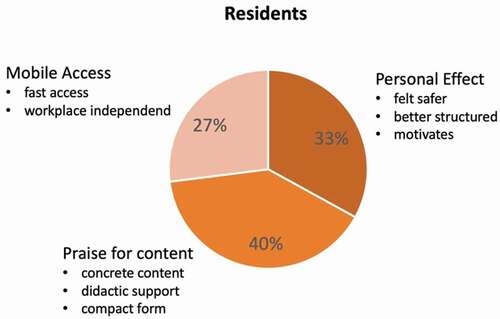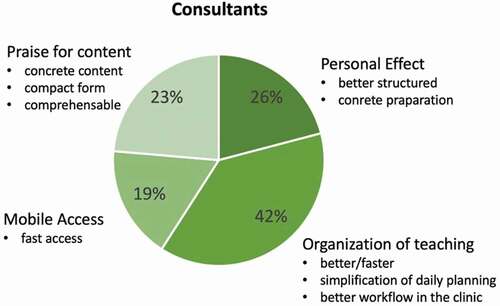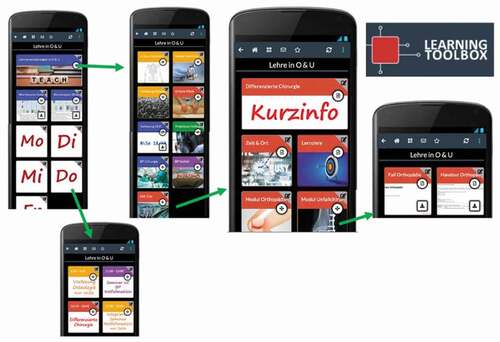ABSTRACT
With rising numbers of students, shorter hospital stays and increasing workload of academic teachers, teaching time have become a scarce resource. Thus, optimal preparation by teachers is key for good clinical teaching. Though a lot of teaching duties are performed by residents in Germany, they are not likely to have been educated in didactic techniques. We developed and evaluated a mobile teaching application using the “Learning Toolbox (LTB)” platform (Raycom BV, Utrecht, Netherlands) that was offered to academic teachers for preparation and support during curricular courses at our medical school. Courses were part of the curricula in Anaesthesiology, Emergency Medicine, and Orthopaedic and Trauma Surgery, and course length could vary up to 40 h per week. Information provided by the novel platform included logistic information, learning objectives, and curricula for the individual courses. A basic tutorial on didactic techniques, suggestions for providing feedback and for enhancing students’ participation was also part of the platform.
After one semester, interviews with teachers indicated an increase in overall satisfaction. Residents appreciated didactic aids and content provided for preparation, leading to higher motivation and self-confidence. The more experienced teachers were particularly satisfied with easy access to scheduling, teaching assignments and daily planning. The app increased teachers’ satisfaction with their performance and enabled better integration of teaching in the daily schedule.
Introduction
With rising numbers of students, shorter hospital stays and increasing workload of academic teachers, teaching time have become a scarce and expensive resource [Citation1]. Thus, optimal preparation of teachers is critical for good clinical teaching [Citation2]. Unlike internal medicine specialities, in the surgical specialities it is not unusual that teaching is delivered by residents, who are unlikely to have been trained in didactic techniques [Citation3,Citation4]. Frequent short notice reassignment of tutors, poor communication, uncertainty about the learning objectives to be achieved, and a low priority of teaching in the daily routine may lead to suboptimal quality of curricular teaching [Citation5]. Thus, adequately prepared tutors are essential to facilitate learning. However, due to complexity and the sheer number of seminars (only the Departments of Trauma, Hand, and Reconstructive Surgery, and Anaesthesiology and Intensive Care Medicine offer more than 40 seminars per week for students in six different semesters) students and faculty have frequently reported difficulties related to organisational issues, provision of adequately prepared tutors, and coordinating patient care with teaching responsibilities.
To reduce these challenges and promote adequate tutor preparation for teaching seminars, we developed and evaluated a mobile teaching application using the “Learning Toolbox (LTB)” platform (Raycom BV, Utrecht, Netherlands). The App facilitates preparation for clinical course content, details organisational details such as location, the timing of seminars, and student semesters. In addition, teaching aids, learning objectives, and supporting aids such as presentation slides with frequently asked questions from students were detailed in the App. We explicitly developed this content to assist tutors to deliver teaching appropriate to the needs of students.
The App was developed and introduced to all doctors of the two departments at the start of the semester. Doctors also received emails with instructions as to how to download and log in to the App, followed by two reminder emails referring all residents and consultants to the App content.
Materials and Methods
LTB was offered to all residents and consultants (n = 108) actively involved in student teaching in the Departments of Trauma, Hand, and Reconstructive Surgery, Anaesthesiology and Intensive Care Medicine. Courses covered Anaesthesiology, Emergency Medicine, and Orthopaedic and Trauma Surgery, and had a duration of up to 40 hours per week. Students were in their second to fourth year in medical school.
Information provided by this novel platform () included logistic information (locations, dates, times, required equipment, student groups and semesters). Clinical content included learning objectives, curricula for the individual course, presentations (with notes on slides) and files, and frequently asked questions relevant to teaching. In addition, we included an introductory tutorial on didactic techniques, how to provide feedback, and enhance students’ participation. Individual events were easily accessible with the App, and an overview providing a complete schedule for an individual teacher or course was added. The authors designed the App to enable quick preparation in case of short-term assignment to a seminar. After one semester of App rollout, we interviewed teachers with different levels of experience in teaching (residents, consultants, ordinary members of faculty).
In order to get a more detailed impression on use of the App we selected from all tutors (n = 88) a subgroup of residents (n = 12) and consultants (n = 6) to participate in semi-structured interviews, each 15 to 20 minutes long. The audio files of the interviews were transcribed anonymously, coded and evaluated using content-based structured qualitative analysis [Citation6].
Interviews commenced with the three questions below, and based on responses, more detailed questions might have been asked.
Interview Questions:
Which features of the App have been rewarding or, on the contrary, disappointing?
Which features of the App have been particularly helpful in organising and delivering teaching activities?
Overall, what benefits did the App offer you?
Results
Results are shown in for residents and consultants, respectively, and have been grouped according to main category (in %) with subcategories specified, but not further quantified. All our interview partners have used the mobile tool on their smartphones, residents obviously more often away from the workplace. Both groups to a similar extent appreciated mobile access, while consultants, probably more often involved in planning and assignment of tutors, put more emphasis on organisational features of the App than on course content. This included easy access to teaching commitments, feasibility in scheduling teaching assignments and matching patient care with teaching (e.g.: “Teaching is no longer (so quickly) forgotten”.).
Figure 2. Pie chart of the 3 categories and further subcategories identified from the interviews with residents (percent, N = 12)

Figure 3. Pie chart of the 4 categories and further subcategories identified from the interviews with consultants (percent, N = 6)

Residents appreciated not only the didactic teaching aids, but also the compact presentation (e.g.: “You can quickly see the contents at a glance”, “The course procedure was clearer to me”.) while their peers mentioned user friendliness as well.
Both groups indicated an increase in satisfaction not only with planning, but also delivery of teaching. Subcategories slightly differed with residents feeling safer when presenting the clinical content (e.g.: “I think the support made it more effective”) and being more motivated (e.g.: “Going into the course so prepared was more motivating for me”.). Consultants added to this the opportunity to better define items like learning objectives (e.g.: “I was more satisfied with the course!”).
Discussion
Based on the success of an App we had developed to support students in an examination course [Citation7] we decided to also develop an App-based approach to counter difficulties in planning and delivery of student courses. This was urgently needed since dissatisfaction with the quality of teaching had frequently been expressed by both students and faculty.
Smartphones and mobile Apps are increasingly used to aid students with learning [Citation8] even in the patient setting. However, most of these platforms focus mainly on drug information and documentation issues [Citation9], and we were not aware of any App supporting planning and delivery of student courses, including items related to organisation, coordination, content, and assessment. We anticipated that this approach might be particularly helpful in supporting departments with high-volume teaching activities as those described in this paper.
The results of our evaluation show that, overall, these expectations have been met. In circumstances when patient care often takes priority over teaching [Citation10,Citation11] the recruitment of residents is necessary. However, this group has received the least training in educating students. On this background the results of our evaluation show that residents can be empowered by an App based approach [Citation12].
Limitations
Though users had the impression that not only organisational issues improved by use of the App, but also quality of education, we are not yet able to support this view with results from a survey in students, indicating whether they also have noticed any change for the better.
Conclusion
Use of the novel mobile platform has yielded promising results regarding improvement in scheduling, preparation and delivery of educational activities, thereby increasing faculty satisfaction and probably also educational quality.
Disclosure Statement
No potential conflict of interest was reported by the author(s).
Additional information
Funding
References
- Garout M, Nuqali A, Alhazmi A, et al. Bedside teaching: an underutilized tool in medical education. Int J Med Educ. 2016 Aug;7:261–4.
- Williams KN, Ramani S, Fraser B, et al. Improving bedside teaching: findings from a focus group study of learners. Acad Med. 2008 Mar;83(3):257–264.
- Dybowski C, Harendza S. Unterricht am krankenbett: allgemeine und fächerspezifische Dozentenmerkmale, Kriterien der Patientenauswahl und Schwierigkeiten. GMS Z Med Ausbild. 2013;30(2):1–17.
- Sultan AS. Bedside teaching: an indispensable tool for enhancing the clinical skills of undergraduate medical students. J Pak Med Assoc. 2019 Feb;69(2):235–240.
- Peters M, Ten Cate O. Bedside teaching in medical education: a literature review. Perspect Med Educ. 2014 Apr;3(2):76–88.
- Qualitative Inhaltsanalyse. Wiesbaden: VS Verlag für Sozialwissenschaften; 2010. p. 601–613.
- Herbstreit S, Mäker D, Szalai C. My personalised app: a tool for improvement of clinical sessions. Usability and satisfaction of medical students. MedEdPublish. 2021;10(1):1–11.
- Jebraeily M, Fazlollahi ZZ, Rahimi B. The most common smartphone applications used by medical students and barriers of using them. Acta Inform Medica AIM J Soc Med Informatics Bosnia & Herzegovina Cas Drus za Med Inform BiH. 2017 Dec;25(4):232–235.
- Shenouda JEA, Davies BS, Haq I. The role of the smartphone in the transition from medical student to foundation trainee: a qualitative interview and focus group study. BMC Med Educ. 2018;18(1):175.
- Ahmed MH. Are good attributes of medical teachers more important than the learning style: a glimpse into the future of medical education and learning. J Public Heal Emerg. 2018;2:18.
- Yeoh K-G. The future of medical education. Singapore Med J. 2019 Jan;60(1):3–8.
- Remskar Konia M. How we can improve physicians’ teaching skills. Acad. Med. 2011;86(2):152–153.

